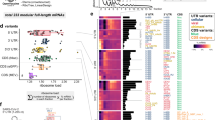Abstract
Thymidylate synthase (TS), an essential enzyme for catalyzing the biosynthesis of thymidylate, is a critical therapeutic target in cancer therapy. Recent studies have shown that TS functions as an RNA-binding protein by interacting with two different sequences on its own mRNA, thus, repressing translational efficiency. In this study, peptides binding TS RNA with high affinity were isolated using mRNA display from a large peptide library (>1013 different sequences). The randomized library was subjected up to twelve rounds of in vitro selection and amplification. Comparing the amino acid composition of the selected peptides (12th round, R12) with those from the initial random library (round zero, R0), the basic and aromatic residues in the selected peptides were enriched significantly, suggesting that these peptide regions might be important in the peptide-TS mRNA interaction. Categorizing the amino acids at each random position based on their physicochemical properties and comparing the distributions with those of the initial random pool, an obvious basic charge characteristic was found at positions 1, 12, 17 and 18, suggesting that basic side chains participate in RNA binding. Secondary structure prediction showed that the selected peptides of R12 pool represented a helical propensity compared with R0 pool, and the regions were rich in basic residues. The electrophoretic gel mobility shift and in vitro translation assays showed that the peptides selected using mRNA display could bind TS RNA specifically and inhibit the translation of TS mRNA. Our results suggested that the identified peptides could be used as new TS inhibitors and developed to a novel class of anticancer agents.
Similar content being viewed by others
References
Carreras C, Santi D V. The catalytic mechanism and structure of thymidylate synthase. Annu Rev Biochem, 1995, 64: 721–762
Chu E, Callender M A, Farrell, M P, et al. Thymidylate synthase inhibitors as anticancer agents: from bench to beside. Cancer Chemother Pharmacol, 2003, S1: 80–89
Yan S, Niu R, Chu E, et al. Molecular mechanisms regulating the expression of thymidylate synthase. Chin J Cell Biol (in Chinese), 2005, 27: 105–108
Chu E, Koeller D M, Casey J L, et al. Autoregulation of human thymidylate synthase messenger RNA translation by thymidylate synthase. Proc Natl Acad Sci USA, 1991, 88(20): 8977–8981
Lin X, Parsels L A, Voller D M, et al. Characterization of a cis-acting regulatory element in the protein coding region of thymidylate synthase mRNA. Nucleic Acids Res, 2000, 28: 1381–1389
Schmitz J C, Liu J, Lin X, et al. Translational regulation as a novel mechanism for the development of cellular drug resistance. Cancer Metastasis Rev, 2001, 20(1–2): 33–41
Takahashi T T, Austin R J, Roberts R W. mRNA display: Ligand discovery, interaction analysis and beyond. Treads Biochem Sci, 2003, 28(3): 159–165
Yan S, Niu R, Zhang P, et al. Identification of peptides that bind with thymidylate synthase RNA using mRNA display technique. Prog Biochem Biophys (in Chinese), 2005, 32(11): 1081–1087
Chu E, Voeller D, Koeller D M, et al. Identification of an RNA binding site for human thymidylate synthase. Proc Natl Acad Sci USA, 1993, 90(2): 517–521
Ja W W, Roberts R W. In vitro selection of state-specific peptide modulators of G protein signaling using mRNA display. Biochemistry, 2004, 43(28): 9265–9275
Voeller D M, Zajac-Kaye M, Fisher R J, et al. The identification of thymidylate synthase peptide domains located in the interface region that bind thymidylate synthase mRNA. Biochem Biophys Res Comm, 2002, 297: 24–31
Sidiqi M, Wilce J A, Vivian J P, et al. Structure and RNA binding of the third KH domain of poly(C)-binding protein 1. Nucleic Acids Res, 2005, 33(4): 1213–1221
Burd C G, Dreyfuss G. Conserved structures and diversity of functions of RNA-binding proteins. Science, 1994, 265(5172): 615–621
Pelletier M, Miller M M, Read L K. RNA-binding properties of the mitochondrial Y-box protein RBP16. Nucleic Acids Res, 2000, 28(5): 1266–1275
Draper D E. Protein-RNA recognition. Annu Rev Biochem, 1995, 64: 593–620
Kenan D J, Query C C, Keene J D. RNA recognition: Towards identifying determinants of specificity. Trends Biochem Sci, 1991, 16(6): 214–220
Marcos J F, Vilar M, Perez-Paya E, et al. In vivo detection, RNA-binding properties and characterization of the RNA-binding domain of the p7 putative movement protein from carnation mottle carmovirus (CarMV). Virology, 1999, 255(2): 354–365
Barrick J E, Roberts R W. Sequence analysis of an artificial family of RNA-binding peptides. Protein Sci, 2002, 11(11): 2688–2696
Baggio R., Burgstaller P, Hale S P, et al. Identification of epitope-like consensus motifs using mRNA display. J Mol Recognit, 2002, 15(3): 126–134
Xu L, Aha P, Gu K, et al. Directed evolution of high-affinity antibody mimics using mRNA display. Chem Biol, 2002, 9(8): 933–942
Hammond P W, Alpin J, Rise C E, et al. In vitro selection and characterization of Bcl-X(L)-binding proteins from a mix of tissue-specific mRNA display libraries. J Biol Chem, 2001, 276(24): 20898–20906
Cujec T P, Medeiros P F, Hammond P, et al. Selection of v-abl tyrosine kinase substrate sequences from randomized peptide and cellular proteomic libraries using mRNA display. Chem Biol, 2002, 9(2):253–264
Author information
Authors and Affiliations
Corresponding author
Additional information
Supported by the National Natural Science Foundation of China (Grant No. 30472043) and the Department of Science and Technology of Shandong Province (Grant No. 2004C07)
Rights and permissions
About this article
Cite this article
Yan, S., Niu, R., Wang, Z. et al. In vitro selected peptides bind with thymidylate synthase mRNA and inhibit its translation. SCI CHINA SER C 50, 630–636 (2007). https://doi.org/10.1007/s11427-007-0078-1
Received:
Accepted:
Issue Date:
DOI: https://doi.org/10.1007/s11427-007-0078-1




